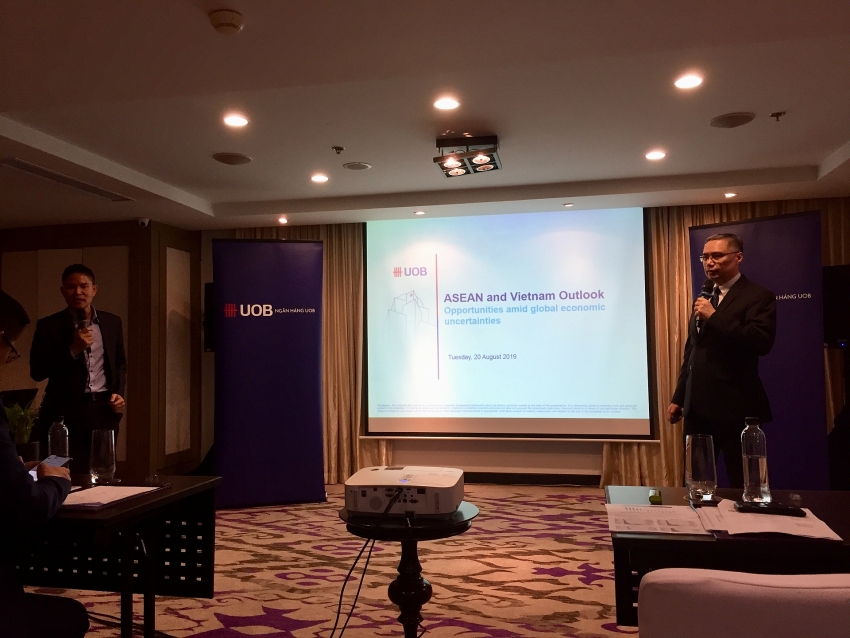Vietnam: Asia’s bright spot amid trade tensions
 |
| Research by United Overseas Bank highlights Vietnam's economic growth |
This assessment was announced yesterday in Hanoi by the researchers of Global Economics and Markets Research, United Overseas Bank (UOB) at a seminar on the Vietnamese economy and its growth dynamics as well as economic trends for the remaining months of 2019.
In the first half of this year, the economy grew by 6.8 per cent year-on-year. All major sectors recorded notable growth, buoyed by manufacturing, construction, and wholesale and retail, which rose by 13, 9.2, and 8.5 per cent, respectively. Tourism also sees a bright outlook with the number of international arrivals surging by 20 per cent.
“We are projecting Vietnam’s GDP growth to reach 6.7 per cent [generally in line with the official growth target of 6.8 per cent] and inflation of around 3.4 per cent for 2019. This will rank Vietnam as one of the fastest-growing economies in the world,” Manop Udomkerdmongkol, economist of UOB, said.
According to the experts, geographic proximity to China, a young labour pool, competitive wages, multilateral trade privileges, and FDI incentives have helped position Vietnam as an attractive investment destination in Asia, laying out a positive growth trajectory for the country in the years ahead.
In first seven months of 2019, Vietnam has recorded 2,064 new projects, 25 per cent higher than in the same period in 2018, setting a new record.
Referring to the causes, UOB said that following the general trend, relocating production facilities to alternative locations has enhanced the shift of global capital flows to destinations not only in Vietnam but also in other ASEAN countries.
The International Monetary Fund's balance of payments analysis also showed a sharp increase in FDI inflows to the ASEAN since the beginning of the third quarter of 2018, when the US-China trade war began to escalate.
“Based on the average FDI inflows to each ASEAN country, it can be assumed that Vietnam and Malaysia are the main beneficiaries of this capital shift,” Manop said.
Another strength of Vietnam as an export production base is its excellent network of trade agreements. A total of 13 free trade agreements (FTAs) have been signed and another three are under negotiation. This means that Vietnamese exports to significant parts of the world are free from tariffs, offering opportunities for manufacturers relocating to Vietnam to sell to more partners at minimal cost.
Eliminating import tariffs on goods, particularly the ones traded in the CPTPP and the EVFTA, will push Vietnam towards domestic reforms and enhance the country’s competitiveness in the medium term. Besides, they also help improve the quality of FDI, attracting more capital to industries like processing and manufacturing, high-tech applications, clean energy, and financial services.
However, one constraining factor for Vietnam is the relatively large proportion of the labour force engaged in the agricultural sector. This could inhibit the manufacturing sector's speed of development in the near-to-medium term, due to the limited supply of skilled workers.
Over the mid- to long-term, Vietnam is striving for sustainable development by tapping into Industry 4.0 to help improve growth quality and elevate standards of living. According to UOB, the government has shown its resolve and determination in carrying out policies related to Industry 4.0, helping to underpin Vietnam’s growth potential in the years ahead.
Regarding monetary policy, UOB predicts that the State Bank will maintain the refinancing rate at 6.25 per cent this year. With current deposit rates, monetary policy continues to create favourable conditions to help GDP grow steadily, and keep prices stable.
To prepare for changes from external factors, according to UOB, it will be important to maintain policies, especially amidst the US-China trade tension.
What the stars mean:
★ Poor ★ ★ Promising ★★★ Good ★★★★ Very good ★★★★★ Exceptional
Related Contents
Latest News
More News
- PM orders investment model for North–South high-speed rail (December 22, 2025 | 17:43)
- First members of Danang International Finance Centre revealed (December 22, 2025 | 17:39)
- Securing capital and efficiency for Vietnam’s 2026-2030 growth ambitions (December 17, 2025 | 10:00)
- Driving double-digit growth through green and circular transformation in Vietnam (December 17, 2025 | 09:00)
- Vietnam bucking trend in the global M&A landscape (December 16, 2025 | 14:20)
- Vietnam’s green transition demands collective financial action (December 15, 2025 | 12:00)
- VIR workshop highlights capital and policy for sustainable development (December 15, 2025 | 11:00)
- National Assembly approves pilot mechanisms to accelerate major projects in Hanoi (December 12, 2025 | 11:29)
- Vietnam eases policy approval requirements, simplifies foreign and outbound investments (December 11, 2025 | 17:53)
- Unpacking new momentum in Vietnam’s M&A market (December 10, 2025 | 09:59)

 Tag:
Tag:



























 Mobile Version
Mobile Version